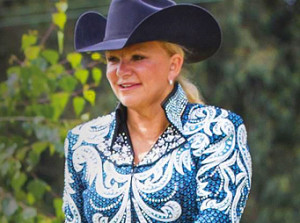Amateur Profile – Nancy Chapman
Click here to read the complete article532 – October, 2017
By Megan Sacia
 As a financial advisor to many high profile clients in the entertainment industry, Nancy Chapman spends her days doing international tax work and highend financial jobs for iconic musicians. But for someone whose daily work revolves around the glitz and glamour of Hollywood moguls, Chapman’s personal path in the horse industry has been far from paved in gold. In fact, with a laundry list of injuries and mishaps that includes a broken neck, a shattered right ankle, a left hip replacement, a clip in her right shoulder muscle, a rod in her neck, and two back surgeries, Chapman’s road to success has been potholed, detoured, and re-routed. But at the age of 67, what she describes as, “well past my sell-by date,” she has never let the obstacles sidetrack her from her goals.
As a financial advisor to many high profile clients in the entertainment industry, Nancy Chapman spends her days doing international tax work and highend financial jobs for iconic musicians. But for someone whose daily work revolves around the glitz and glamour of Hollywood moguls, Chapman’s personal path in the horse industry has been far from paved in gold. In fact, with a laundry list of injuries and mishaps that includes a broken neck, a shattered right ankle, a left hip replacement, a clip in her right shoulder muscle, a rod in her neck, and two back surgeries, Chapman’s road to success has been potholed, detoured, and re-routed. But at the age of 67, what she describes as, “well past my sell-by date,” she has never let the obstacles sidetrack her from her goals.
Like so many others, Chapman describes herself as a “horse-crazy” young girl. Her story in the horse industry began on her grandparents’ Louisiana farm, where she spent her youth barrel racing and pole bending. But when her family situation changed, she sadly bid farewell to time in the saddle. Had you told her then that it would be decades before she’d own another horse, she would have never believed you.
“At 40, my youngest went off to college, and I realized I was at a point in my life where I had the time and money to get back into horses,” Chapman recalls. Living in southern California, she had no ties to the Quarter Horse industry at the time, so she connected with a nearby Hunter/Jumper trainer to take lessons, which led to a 10- year stint in the Hunter/Jumper world and on the A circuit.
Everything changed in 2000 when, aboard a sale horse represented by her trainer, Chapman took a header over a jump, paralyzing her from the neck down. “Gradually, over a number of days, I got feeling back in my seat, but I had problems from my waist to my neck. Thankfully, through my entertainment industry connections, I was transferred to a Los Angeles neurosurgeon, who was referred by Christopher Reeves’s doctor. Through advancements in surgery and technology, they were able to fix me. But even three years prior to that, the outcome would have been very different,” Chapman says.
Click here to read the complete article532 – October, 2017










